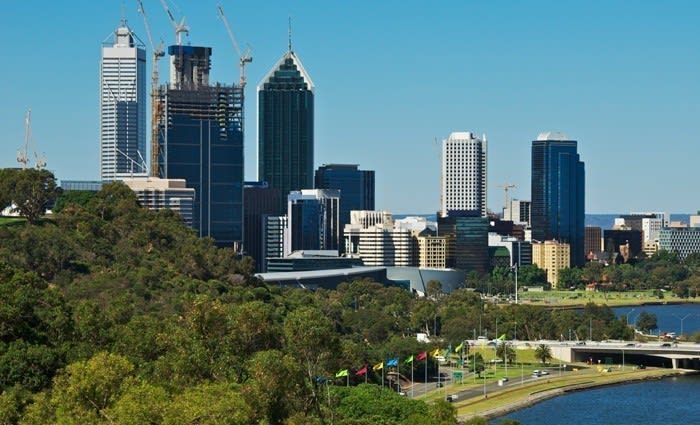Squandering riches: can Perth realise the value of its biodiversity?
![]()
GUEST OBSERVER
Perth is not known as a model for suburbia and its suburban condition is similar to that of developed cities the world over.
However, it does stand out in one respect: it sits in an exceptionally biodiverse natural setting. A strong, informed vision for this setting’s relationship with the city could help Perth become an exemplar for similarly positioned metropolises everywhere.
The greater Perth region has been designated the Southwest Australia Ecoregion (SWAE). This is one of only 35 “biodiversity hotspots” in the world.
Reconciling future growth with biodiversity is a key issue for urban design and planning this century. Indeed, if current trends continue, global urban land cover will increase by 1.2 million square kilometres(equivalent to half the area of Western Australia) by 2030. Much of this will happen in biodiversity hotspots.
This is important because it is estimated we will lose nearly half of all terrestrial species if we fail to protect the hotspots. We will also lose the ecosystem services upon which human populations ultimately depend.
“Ecosystem services” may sound like abstract jargon, but it’s actually a term used to describe the services nature provides – such as clean air, water and food, and heatwave and flood mitigation. Without these, human life would be extremely unpleasant, if not unviable.
Perth has a reputedly strong planning system and is comparatively wealthy. If it can’t control its city form to protect biodiversity – compact cities generally being recognised as the best model for protecting land for conservation – then city administrators elsewhere, particularly in the developing world, are likely to struggle.
Misreading the land
The current treatment of the Australian environment has its roots in the European annexation of Australia, which has been characterised by catastrophic misreadings of the land. Governor James Stirling, who was singularly responsible for the European annexation of Perth, was the kind of man who saw what he wanted to see rather than what was there. In The Origins of Australia’s Capital Cities, Geoffrey Bolton writes:
"…arriving at the end of … an uncommonly cool, moist summer, [Stirling was] misled by the tallness of the northern jarrah forest and the quality of the alluvial soils close to the river into believing that the coastal plain would offer fertile farming and grazing. It was, Stirling wrote, equal to the plains of Lombardy; and he persuaded himself that the cool easterly land breeze of these early autumn nights must originate from a range of snowy mountains."
The results of such misinterpretations of the land were generally less poetic. Stirling sited the settlement of Perth on a narrow, constrained strip of land between swamps to the north and marshy river edges to the south. These low-lying areas fuelled plagues of mosquitos and, once polluted, deadly typhoid outbreaks.
In time, due to a lingering discomfort with Perth’s “unsanitary” wetlands, more than 200,000 hectares – an area equivalent to 500 Kings Parks – were drained on the Swan Coastal Plain. These biologically productive areas directly or indirectly support most of the coastal plain’s wildlife, so the effects on biodiversity have been catastrophic.
Furthermore, a perception of the Banksia woodland and coastal heath on Perth’s fringes as unattractive and useless has seen much of it cleared for the expansion of the city. Between 2001 and 2009, suburban growth consumed an annual average of 851ha of highly biodiverse land on the urban fringe.
The lesson from this experience is that any future growth in a biodiversity hotspot, or indeed elsewhere, has to be founded on the understanding that we cannot continue to bend nature to our will. We must learn how to work with it.
Within this humbling process, we need to recognise that working with the land is not an entirely pure or noble act; rather, it is imperative for humanity’s survival. As species and ecosystems become threatened and vanish, so too do the ecosystem services that support human wellbeing.
Perth’s Green Growth Plan
The release of the state government’s long-anticipated Perth and Peel Green Growth Plan for 3.5 million may herald a shift in the relationshipbetween the city and the biodiversity hotspot. The plan encapsulates two broad goals:
- to protect fringe bushland, rivers, wetlands and wildlife in an impressive 170,000 hectares of new and expanded reserves on Perth’s fringe
- to cut red tape by securing upfront Commonwealth environmental approvals for outer suburban development.
While ostensibly positive achievements, a question remains as to the implications of clearing a further 45,000ha (3% of the Swan Coastal Plain) of remnant bushland which is not protected by the conservation reserves.
Furthermore, the typically disconnected conservation reserves proposed in the Green Growth Plan lack overall legibility. This stymies the public’s ability to conceptualise the city’s edge, which leads them to care about it (like London’s greenbelt, for instance).
Finally, a question remains about how a plan that places restrictions on outer suburban development will accommodate the powerful local land development industry over time. This is a concern given the frequent “urban break-outs” – where urban development occurs outside nominated growth areas – between 1970 and 2005.
In 2003, the ABC asked revered Western Australian landscape architect Marion Blackwell, “Are we at home now in the land we live in?” She replied, “No, we’re not. We don’t know enough about it, and not enough people know anything about it.”
We still have work to do on our engagement with biodiversity in Western Australia, and Perth specifically, before we can become a model for future cities.
esearch fellow, Australian Urban Design Research Centre, University of Western Australia and author for The Conversation. He can be contacted here.
